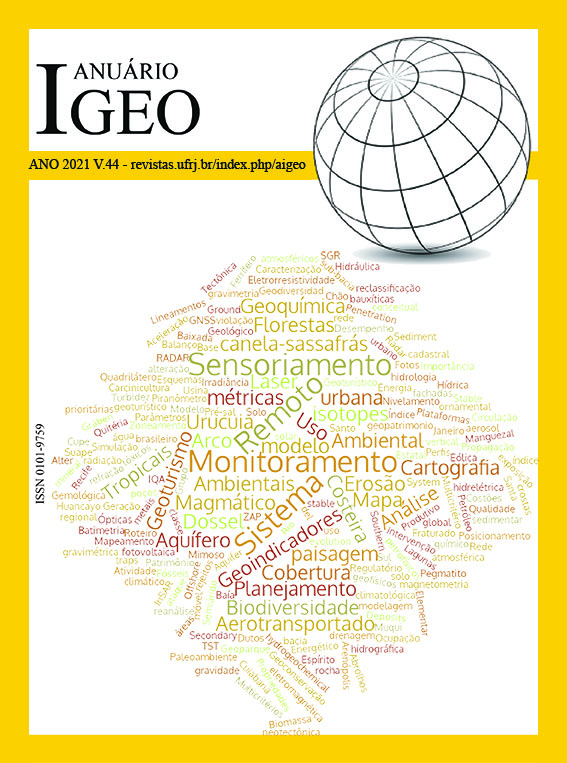Inverse Margin Filtration Applied for Surface Water Treatment
DOI:
https://doi.org/10.11137/1982-3908_2021_44_40923Palavras-chave:
Lentic ecosystems revitalization, Inverse margin filtration, Filtration distanceResumo
Technologies to be applied under the context of protection and revitalization of surface water must be developed and improved in order to enhance the quality of aquatic ecosystems. In this way, this study aimed to evaluate the treatment performance of an inverse margin filtration system (IMF) applied in surface water treatment. The IMF was monitored during 1 year through the classic water quality parameters, and thus the treatment performance along the filtration path was identified. The results showed an average removal efficiency of 41% for turbidity, 35% for apparent color, 43% for true color, 26% for total suspended solids and total organic carbon, 53% for nitrogen, 46% for phosphorus, 91% for iron, 8% for manganese, and 100% for fecal coliforms. In this way, the IMF system proved to be a technology that can be applied in the treatment of water in lentic environments.
Downloads
Referências
ABNT. 2007. Associação Brasileira de Normas Técnicas. NBR 15495-1/07: Poços de monitoramento de águas subterrâneas em aquíferos granulares.
APHA. 2017. American Public Health Association. Standard methods for examination of water and wastewater. 23. ed. Washington, DC.
Arantes, E.J. 2003. Emprego de infiltrômetros na caracterização da interação entre rio e aquífero. Programa de Pós-Graduação em Hidraúlica e Saneamento, Universidade de São Paulo de São Paulo, Dissertação de Mestrado, 103p.
Bertelkamp, C.; Verliefde, A.R.D.; Schoutteten, K.; Vanhaecke, L.; Bussche, J. Vanden; Singhal, N.; Hoek, J.P. 2016.The effect of redox conditions and adaptation time on organic micropollutant removal during river bank filtration: a laboratory-scale column study. Science of The Total Environment. 544:318. http://dx.doi.org/10.1016/j.scitotenv.2015.11.035.
Bourg, A.C.M.; KedzioreK, M.A.M. & Darmendrail, D. 2002. Organic matter as the driving force in the solubilization of Fe and Mn during riverbank filtration. In: RIVERBANK FILTRATION: UNDERSTANDING CONTAMINANT BIOGEOCHEMISTRY AND PATHOGEN REMOVAL. Dordrecht: Kluwer Academic Publisher, p. 43-54.
CONAMA. 2005. Conselho Nacional do Meio Ambiente, resolução 357/2005. Dispõe sobre a classificação dos corpos de água e diretrizes ambientais para o seu enquadramento, bem como estabelece as condições e padrões de lançamento de efluentes, e dá outras providências. Brasília/ Disponível em: < http://www2.mma.gov.br/port/conama/legiabre.cfm?codlegi=459> Acesso em: 15 dez. 2020.
Dash, R.R.; Mehrotra, I.; Kumar, P. & Grischek, T. 2008. Lake bank filtration at Nainital, India: water-quality evaluation. Hydrogeology Journal, 16(6):1089-1099.
Grischek, T.; Schubert, J.; Jasperse, J. L.; Stowe, S. M.; Collins, M.R 2007. What is an appropriate site for RBF? In: Management of Aquifer Recharge for Sustainability. USA: Acacia Publishing Incorporated.
Grünheid, S.; Amy, G. & Jekel, M. 2005. Removal of bulk dissolved organic carbon (DOC) and trace organic compounds by bank filtration and artificial recharge. Water Research, 39(14): 3219-3228. https://doi.org/10.1016/j.watres.2005.05.030.
Kuehn, W. & Mueller, U. 2000. Riverbank Filtration: an overview. Journal American Water Works Association, 92(12):60-69. https://doi.org/10.1002/j.1551-8833.2000.tb09071.x
Hu, B.; Teng, Y.; Zhai, Y.; Zuo, R.; Li, J. & Chen, H. 2016. Riverbank filtration in China: a review and perspective. Journal of Hydrology, 541: 914-927. https://doi.org/10.1016/j.jhydrol.2016.08.004
Maeg, S.K.; Sharma, S.K.; Magic-Knezev, A. & Amy, G. 2008. Fate of effluent organic matter (EFOM) and natural organic matter (NOM) through riverbank filtration. Water science and technology, 57(12): 1999-2007. https://doi.org/10.2166/wst.2008.613
Massmann, G.; Nogeitzig, A.; Taute, T. & Pekdeger, A. 2008. Seasonal and spatial distribution of redox zones during lake bank filtration in Berlin, Germany. Environmental Geology, 54 (1): 53-65. https://doi.org/10.1007/s00254-007-0792-9
Missimer, T.M.; Ghaffour, N .; Deewah, A.H.A.; Rachman, R.; Maliva, R.G. & Amy, R. 2013. Subsurface intakes for seawater reverse osmosis facilities: Capacity limitation, water quality improvement, and economics. Desalination, 322: 37-51. https://doi.org/10.1016/j.desal.2013.04.021
Romero-Esquivel, L.G. 2012. Remoção de matéria orgânica natural e precursors de trialometanos por filtração em margem na Lagoa do Peri, Santa Catarina, Brasil. Programa de Pós-graduação em Engenharia Ambiental, Universidade Federal de Santa Catarina, Tese de de Doutorado, 246 p.
Shamsuddin, M.K.N.; Sulaiman, W.N.A.; Suratman, S.; Zakaria, M.P. & Samuding, K. 2013. Conjunctive use of surface water and groundwater via the bank infiltration method. Arabian Journal of Geosciences, 7(9): 3731-3753. Walsh, C. 2000. Urban impacts on the ecology of receiving waters: a framework for assessment, conservation and restoration. Hydrobiologia, 107: 107-114.
Weber, K. 2016. Microbial Community Assessment in Wetlands for Water Pollution Control: past, present, and future outlook. Water, 8(11): 503. https://doi.org/10.3390/w8110503
Downloads
Publicado
Como Citar
Edição
Seção
Licença
Copyright (c) 2021 Anuário do Instituto de Geociências

Este trabalho está licenciado sob uma licença Creative Commons Attribution 4.0 International License.
Os artigos publicados nesta revista se encontram sob a llicença Creative Commons — Atribuição 4.0 Internacional — CC BY 4.0, que permite o uso, distribuição e reprodução em qualquer meio, contanto que o trabalho original seja devidamente citado.
















 Exceto onde indicado de outra forma, o conteúdo deste site é licenciado sob uma licença
Exceto onde indicado de outra forma, o conteúdo deste site é licenciado sob uma licença 